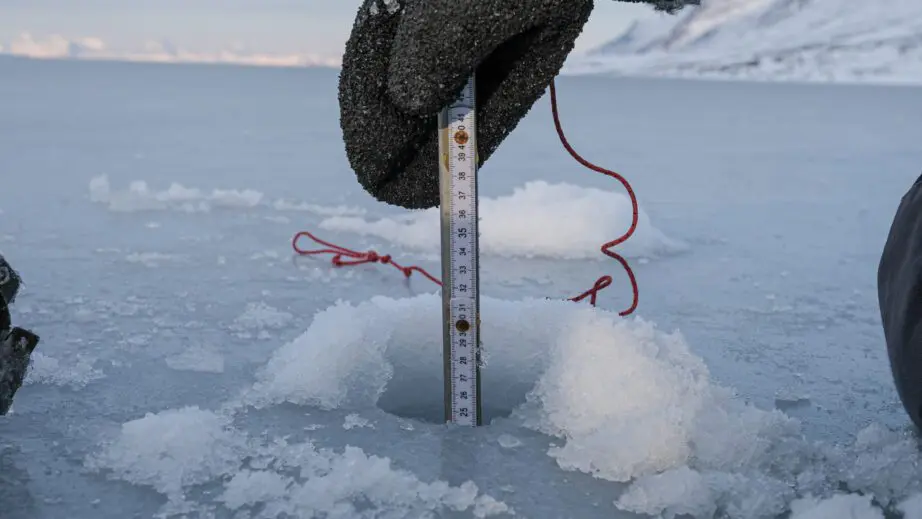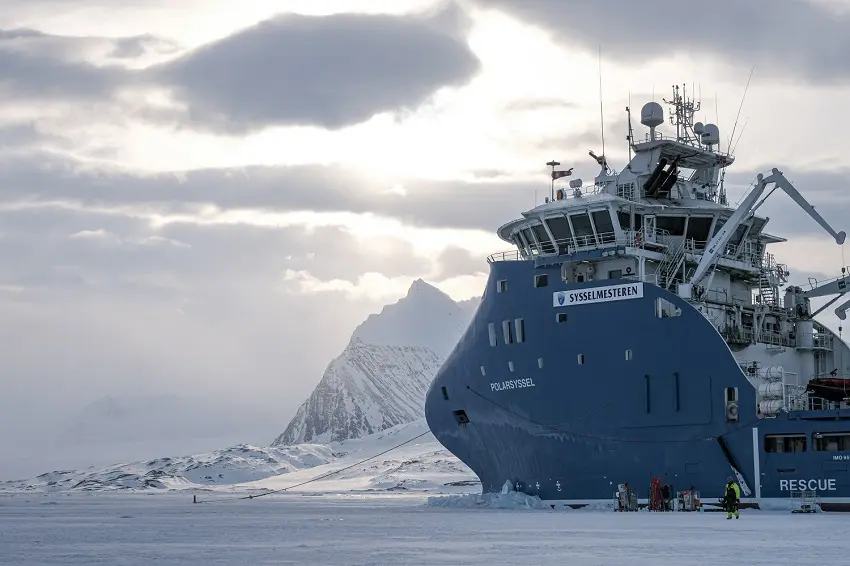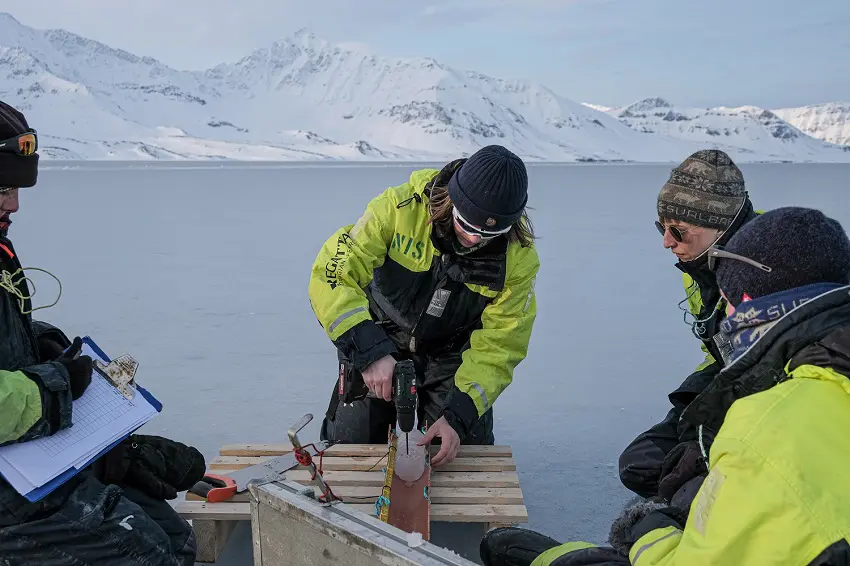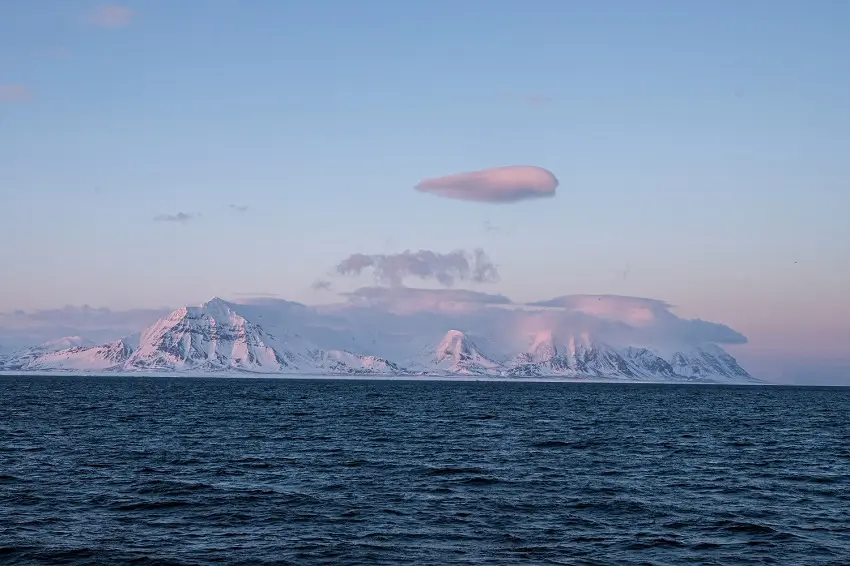The ocean’s role in a warming Arctic
When meteorologists report fine weather on Svalbard, it is the air temperature that is being talked about. But when it comes to global warming, ocean temperature is the big joker.

Geophysics students doing fieldwork in St. Johnsfjorden. Photo: Maria Philippa Rossi
When meteorologists report fine weather on Svalbard, it is the air temperature that is being talked about. But when it comes to global warming, ocean temperature is the big joker.
Text: Frank Nilsen (Professor of Oceanography), Ragnheid Skogseth (Associate Professor of Physical Oceanography) and Maria Philippa Rossi (Information Advisor)
We learned early on that it is the Gulf Stream we can thank for the pleasant, mild climate along the Norwegian coast. The warm ocean current that transports warm water from the Caribbean Sea across the Atlantic, up along Norway and towards Svalbard ensures a mild, rainy climate in Bergen almost all year round. It is this current you can thank for the apple trees blooming in Hardanger in the spring, and for being able to ski in Lofoten in April, in shorts and a T-shirt.
As permanent residents of Svalbard, we also notice the effect of this Atlantic heat transport. In the Barents Sea south of Spitsbergen, it changes its name to the West Spitsbergen Current, but it is the same warm water from the Caribbean, which gives us increased sea temperatures and changed species diversity in Isfjorden.

A turning point in the ocean
Two of us have lived in Longyearbyen since 2001. A period of 20 years is small in a climate context where long time series are needed to distinguish natural variations from trends over a longer time period. Unfortunately, it has turned out that 20 years as a researcher on Svalbard has been enough to both see and feel climate change.
What happened in the winter of 2006 led to a dramatic change:
In January 2006, the low pressures were in line on their way north from the North Atlantic towards the Arctic, heading for the Fram Strait between Svalbard and Greenland. The usual route for these weather systems is east of Svalbard into the Barents Sea, but the low pressures this winter were west of Svalbard, bringing warm air all the way from Spain to Svalbard.
In addition to ten January days with plus degrees and the fact that the ice from the Arctic was pushed northward, these southerly winds changed the current systems west of Svalbard. The result was a flooding of warm Atlantic water on the continental shelf along the west coast of Svalbard. In February, the wind turned northerly and the air temperature dropped to -20°C. Despite the biting cold, the sea ice dissolved and disappeared due to warmer water temperatures.
The ocean as a buffer
What we witnessed was that the northerly wind had “opened the door” to the fjords for all the warm water that had been redirected to the west coast of Svalbard. The sea temperature was over 3°C in the surface water in the West Spitsbergen fjords. Sea ice forms at -1.8°C, so the sea had no problems melting the ice, even though it was double-digit blue degrees in the air.
The ocean acts as a buffer and a redistributor of the excess heat from the greenhouse effect. Much of the greenhouse gases we emit and most of the surplus heat from the greenhouse effect are taken up by the ocean over time instead of accumulating in the atmosphere. Therefore, it is in the sea we will find the answer to what the climate of the future will be, especially in the northern areas since this excess heat flows north and is released there. This is a crucial factor in the rise of the air temperature, which has risen more than twice as much around Svalbard compared with the global average temperature rise.
Life adapted to the polar sea areas will at some point suffer and be changed or collapse since a rise in temperature will lead to better conditions for species at lower latitudes and increased CO2 content will lead to ocean acidification. In addition, when water gets warmer, it expands. Together with the melting of ice on land, it causes the sea to rise.

Long-term changes
In the sea, all processes are 10 times slower than in the atmosphere, but it also means that temperature changes in the sea can affect Svalbard 10 times longer. The front between warm Atlantic water and cold water from the Arctic is around Svalbard, so a small shift of this front has major consequences for the sea temperature around Svalbard, the sea ice cover and which biological species will thrive in the fjords on Svalbard.
In the Arctic, the average annual temperature rises twice as much as in the rest of the world. Most of the increase can be explained by the ocean’s buffer function, and its ability to redistribute heat northwards. The heat capacity in the ocean is much greater than in the atmosphere. A temperature increase of around 1°C can melt all sea ice in the fjords on the west side and north of Svalbard, and at the same time emit enough heat to the atmosphere which explains the increase in air temperature locally on Svalbard.

The important research
Since UNIS’ inception almost 30 years ago, researchers have collected oceanographic data around Svalbard, and especially in the fjords on the west side of Spitsbergen. Several departments have contributed, but the oceanographers at the Department of Arctic Geophysics (AGF) have collected, calibrated, and created a database of the hydrographic data.
Cooperation across departments and the utilization of common infrastructure have yielded good results. Students in marine subjects at UNIS have also been involved in the collection and work with this data, and it has been very valuable for the learning outcome. Colleagues from other national and international institutions have contributed data, and the UNIS Hydrographic Database has been published (Skogseth et al., 2019).
Recently, a scientific article was published with the focus on Isfjorden (Skogseth et al., 2020). This study shows clear changes in Isfjorden alongside the local warming climate and a great reduction in the fjord ice. During the last three decades, the water in Isfjorden has increased by 1°C per decade in winter, a total of 3°C for the entire period. For the summer, the corresponding increase is almost 2°C over these three decades.
This summer, UNIS has a new research boat, Hanna Resvoll, in place in Longyearbyen. Good access to the sea and possibilities for frequent sampling, helps to increase our knowledge of the processes behind the changes in Isfjorden.
We have lost sea ice in the winter but gotten Atlantic cod in the fjords in the summer and autumn. This is an example of the sea being the joker that plays a crucial role in the climate system. A few weeks of changed weather systems around Svalbard have led to persistent warm fjords since 2006.
It is worth noting that the water masses in Isfjorden were transformed into an almost Arctic fjord in 2020, and thus were ready for ice formation in the winter of 2021. Unfortunately, the atmosphere had become too warm to manage cooling the fjord to the freezing point…

Sources:
Skogseth, R., Ellingsen, P., Berge, J., Cottier, F., Falk-Petersen, S., Ivanov, B., Nilsen, F., Søreide, J. and Vader, A. (2019). UNIS hydrographic database [Data set]. Norwegian Polar Institute. https://doi.org/10.21334/unis-hydrography.
Skogseth, R., Olivier, L.L.A., Nilsen, F., Falck, E., Fraser, N., Tverberg, V., Ledang, A.B., Vader, A., Jonassen, M., Søreide, J., Cottier, F., Berge, J., Ivanov, B.V., Falk-Petersen, S., 2020. Variability and decadal trends in the Isfjorden (Svalbard) ocean climate and circulation – An indicator for climate change in the European Arctic. Progress in Oceanography, 187, 102394, https://doi.org/10.1016/j.pocean.2020.102394.